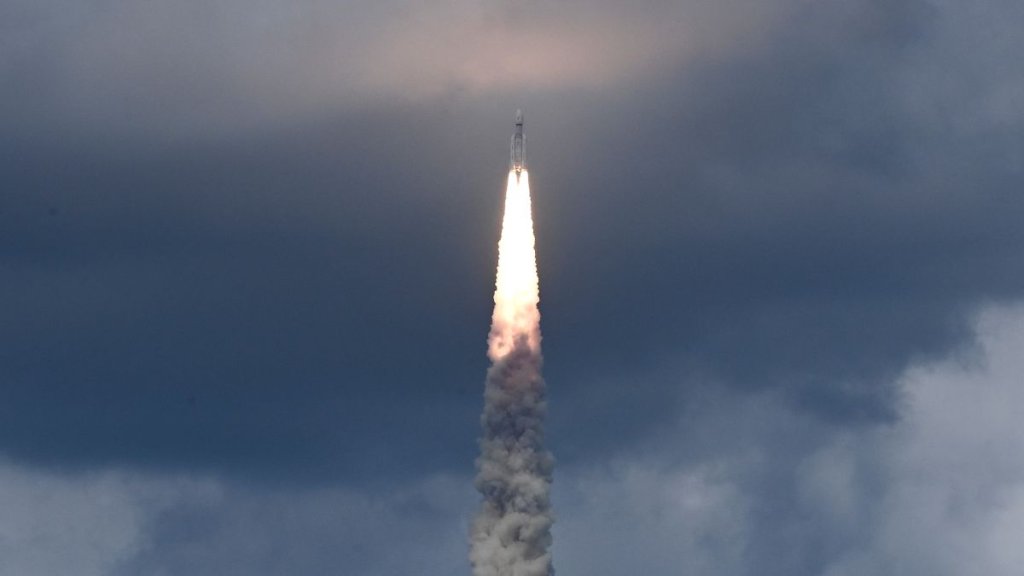India has embarked on its latest ambitious voyage to the moon.
A Launch Vehicle Mark-3 (LVM3) rocket topped with the Chandrayaan-3 spacecraft lifted off from the Satish Dhawan Space Centre on the coastal island of Sriharikota today (July 14) at 5:05 a.m. EDT (0905 GMT; 2:35 p.m. local time in Sriharikota).
The rocket thundered into the sky, carrying an uncrewed lander-rover duo and the hopes of the world’s most populous nation. About 16 minutes after liftoff, Chandrayaan-3 separated from the LVM3 as planned and entered orbit around Earth, kickstarting its fuel-efficient journey to the moon. If the rest of the mission unfolds as planned, India will soon become the fourth country — after the United States, the former Soviet Union and China — to land on the moon.
Related: Chandrayaan-3: A guide to India’s third mission to the moon
The ambitious, homegrown mission has a relatively modest price tag of 6 billion rupees ($73 million). Its success would accelerate India’s growing ambitions of low-cost space exploration during a time when many nations are vying to establish a long-term presence on the moon.
Today’s launch commenced India’s second shot at gently landing on the moon’s surface, a venture that comes nearly four years after Chandrayaan-2’s lander-rover pair crashed into the moon due to a software glitch. Officials at the Indian Space Research Organisation (ISRO), the country’s national space agency, say they’re confident of success this time around.
That confidence will be tested over the next month, as multiple firings of the spacecraft’s thrusters stretch its egg-shaped path around Earth, increasing its speed until it can be hurled into the moon’s orbit. Once there, precise maneuvers must safely perch the lander-rover duo near the moon’s south pole, a mainly uncharted region that India dreams of being the first to unveil.
“This mission is most significant in terms of ultimate precise landing capability of [the] Chandrayaan-3 lander on the specified lunar surface,” Arun Sinha, a former senior scientist at ISRO, told Space.com.
The mission’s landing zone measures 2.5 miles by 1.5 miles (4 by 2.5 km) and sits at 69.367621 south latitude and 32.348126 east longitude, which happens to be near the planned touchdown site of Russia’s Luna 25 spacecraft, which is scheduled to launch in August. A hotspot in space exploration, the lunar south pole is thought to harbor abundant water ice, which scientists think can be mined for rocket fuel. Lunar water ice could also be crucial for life support, making the south pole region a tantalizing target for moon bases.
Chandrayaan-3’s touchdown, targeted for Aug. 23 or Aug. 24, would be historic; successful past missions have landed near the moon’s equator, and those that aimed to reach the south pole have failed. Unlike more accessible equatorial areas, where sunlight is plentiful for solar-powered spacecraft, the south polar regions receive sunlight at low angles, and the long shadows there make safe landing a challenge.
ISRO scientists are banking on a new algorithm encapsulated into Chandrayaan-3’s software. Rather than interpret speed from static images as Chandrayaan-2 did, the new technology onboard Chandrayaan-3 is designed to estimate spacecraft speed in real time as the probe descends toward the lunar surface.
In addition, the legs on the lander, which is named Vikram (Sanskrit for “valor”), have been strengthened to help it survive a slightly high landing speed. And the area in which the spacecraft can touch down has also been significantly widened to allow some room for error and ultimately increase chances of success, ISRO Chairman S. Somanath said last week during a press briefing.
Assuming a safe touchdown, a six-wheeled rover named Pragyan (Sanskrit for “wisdom”), powered by its own tiny solar array and guided by cameras to avoid obstacles, will roll off Vikram onto the lunar surface. It is armed with a spectrometer to analyze lunar soil and rocks and a laser-induced spectroscope to zap its targets and derive their chemical composition. The rover and lander are both expected to operate for one lunar day (about two Earth weeks), from sunrise to sunset on the moon.
While the solar-powered robotic duo is not expected to survive a frigid night on the moon, “there are faint chances of extra-efficient battery charge,” Sinha told Space.com. “If this is good, another 14 [Earth] days might be available.”
Related: What is the moon made of?
Vikram is equipped with a seismometer to sense moonquakes, which help scientists infer the moon’s structure; a thermometer-like instrument that will for the first time penetrate the lunar soil to record its temperature; a probe to study plasma close to the surface; and a retroreflector sent by NASA “to understand the dynamics of [the] moon system,” according to the mission plan.
Chandrayaan-3 is the latest effort of India’s burgeoning space ecosystem, unfolding nearly a month after the country signed the Artemis Accords for peaceful moon exploration. To boost its space economy, India issued its national space policy in April. The document was highly anticipated by the country’s budding commercial space sector and allows private startups, which have nearly doubled since 2020, to conduct rocket launches — an operation that has historically been dominated by ISRO.
Chandrayaan-3 will also demonstrate India’s indigenous technology, which is empowering the nation to collaborate with countries worldwide on various missions. For example, in 2024, India is scheduled to launch NISAR (short for NASA-ISRO Synthetic Aperture Radar), an observatory in low Earth orbit that will fly two radars, one contributed by each country, to monitor minute changes in Earth’s surface. Further down the pipeline of missions, the country has partnered with Japan’s space agency for the Lunar Polar Exploration (LUPEX) mission to study water ice lingering in permanently shadowed regions on the moon.
Launching at a time when multiple nations are competing to reach the moon and establish a long-term presence near its south pole, the Chandrayaan-3 mission will help shape India’s role in future lunar exploration.

